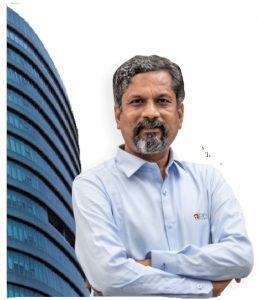Sridhar Vembu, Founder and CEO of Zoho Corporation is an illustrious example of a successful start-up entrepreneur. This product of Princeton University acknowledges the inspiration he derives from S Gurumurthy, the Swadeshi Jagran Manch ideologue and attributes to him his yen for swadeshi self-reliance and de-centralised rural cluster development. We provide excerpts from his recent address at the Chennai International Centre on doing business during and after Covid19
Vembu pointed to the surge in demand for ventilators, masks and a variety of medical goods and pharmaceuti- cals. The supply chains for lot of these are dependent on China. With China also having her own problems there is uncertainty over accessing these goods. Not just India, but Europe, USA and other countries also are facing this problem.
END OF THE WASHINGTON CONSENSUS ERA
Post-World War, the United States was the champion of globalisation and free trade. Vembu opined that US is steadily moving away from globalisation. Not just the Trump administration; there are critics in the US of glo- balisaiton across its political spectrum. Even in the post Trump era, globalisation, probably, will not be led any more by the US. The Washington consensus thus appears dead.
So far, India’s economic policy has been driven by the Washington consensus of trade liberalisation and opening up of the economy. Vembu argued that this policy has denied our country the abil- ity to build advanced technologies: “we don’t even aim to build such capabilities in all possible fields. Even in pharmaceuticals, where India has been a leader, the country is heavily dependent on China, actually up to 80 per cent, for the Active Pharma- ceutical Ingredients (API). We are assembling chemicals, we do not make drug molecules. We seem to specialise in getting FDA approvals and other processes to market drugs rather than mastering the chemis- try and biochemistry involved. We are happy to outsource these to China,” said Vembu.
| Zoho Corporation has set up a R&D centre in Tenkasi. The 500 strong centre is working on leading edge tech- nologies in artificial intelligence and AI based tools. Sophisticated software frameworks are built right at this village office. Vembu pointed to the congenial environment, sound infrastructure like quality roads, copious availability of skilled workforce from educational insti- tutions in the vicinity, excellent telecom and broadband connectivity and, most important, low cost of land: “all talent is sourced from colleges within a radius of 50-100 km. A fifth of employees come from Zoho. A handful of faculty members train the recruits. There is no dearth of talent.” Vembu works from the village several hundred miles away from the Chennai metro, enjoying a much higher quality of life and handles meetings, sessions, in-terviews… Zoho has built another rural centre in Vembu’s native village near Kumbakonam. He mentions that all the state-of-the-art work done at Silicon Valley or London or the Netherlands are done at Tenkasi. Zoho has been investing on R&D in semiconductors including their design. Vembu plans also to work on tech- nologies relating to medical equipment, transportation… Vembu referred to three fundamental aspects of his business economics- balance, symmetry and harmony. He explained with illustration that business should first aim at balancing the costs of inputs and outputs. The second aspect he explained, as goods purchased and sold must have symmetry: as an example he pointed to the risk of Saudi Arabia, having oil as its major product to sell but not balanced by the goods it buys. A steep fall in price of oil will hurt its trade balance and hence its economy; the third and final aspect relates to harmonizing the economies of a region or a territory. Vembu explained that working on a R&D project is like making movies. Both have uncertain pay-offs. India specialises in making movies; it knows the risks involved investing in R&D. India has borrowed a lot of business concepts from the UK and the USA. The latter had the culture for R&D in abundance. But with its obsession over continuous im- provement in quarterly financial results, the country has lost much of its lead. Vembu pointed to large companies like BMW, Toyota or Samsung nurturing development through R&D projects spread over a long time that enabled them to come with world beating products time and again. |
ZOHO, THE SAAS LEADER ZOHO CORP IS an enterprise software product company that blossomed at the right time, when sof tware as a service (SaaS) model was the new global mantra. Given its unconventional approach to talent building and product sales, Zoho’s revenue has crossed half a billion dollars. The company has also inspired several others to innovatively compete in the business software arena. Led by Zoho, Chennai is now acknowledged as the SaaS capital of India. Zoho has been focused on leveraging the oppor tunity offered by the introduction of GST regime to penetrate the SME market oppor tunity within India. – N LakshminarayananAt the Silicon Valley few companies like Microsoft and Apple make long term R&D investments. But in the case of many start-ups, new products are launched fast, but they are just minimum viable products not sustained by continuous R&D investments. India has to learn from these approaches. Vembu felt that south India, particularly Tamil Nadu, has a lot of talent and willing to work on R&D projects over long periods. Zoho Corporation has been working on such R&D projects over the last 10-15 years. “The products that we sell today are the result of years of R&D efforts,” said Vembu. It is interesting to hear Vembu pointing to discarding the old way of doing research and development of en- gineering products in expensive workshops. These are increasingly treated as software projects with a modest lab attached. Perhaps with a prototyping unit, software engineers play with product concepts on CAD- CAM in the computer; eventually they perfect the design in models continuously refined on the computer, make prototypes, test and fine-tune the test results with com- puter aided designs. These are just like development of software. So such product development can be done in a small village. These do not require costly space in a metro like Chennai or Bengaluru. A 100 per cent design centre can work effectively at Tenkasi or Kumbakonam. |
| THE ASSEMBLE IN INDIA PRESCRIPTION OF CEA WHILE PRESENTING THE Economic Survey, Chief Economic Adviser, Krishnamur thy Subramaniam, pointed to the scope for handsome job growth focusing on assembly and not just on manufacturing; he advocated ‘Assemble in India’ as part of the ‘Make in India’ initiative. Tamil Nadu has already been excelling in this by leveraging availability of a large workforce at modest wages. Two Taiwanese companies – Foxconn and Feng Tay – have been extremely successful in this effort. Feng Tay employs around 23,500, mostly women (18,500), not even literate,drawn from the rural belt around Cheyyar, assembling Nike shoes in millions for expor ts to the US and Europe; and Foxconn employs 15,000 each, mostly women, in two plants at Sriperumbudur and Sri City, assembling cell phones. Foxconn, which earlier assembled such phones for Nokia, has star ted assembling Apple phones at its sprawling facility at the old Nokia complex at Sriperumbudur. These plants employ local women in thousands on decent wages and are highly successful foreign ventures for assembly of impor ted components. Thus, the suggestion for India becoming par t of the global supply chain appears great and attractive. |

REAL ESTATE MONSTERS OF METROS |
| FUTURE PLANS It was so encouraging to hear Vembu’s plans for making heavy investments in artificial intelligence: “lots of AI tools are actively built now. We are building new programmes, new languages, new clause of frameworks,” he said. The optimism of Vembu appeared infectious. His exhortation on India innovating high value products re- ducing dependence on imports is of great significance and a much needed imperative. His stress on shifting focus to villages will again help balanced development of the dif- ferent regions, spreading prosperity to less industrialised areas. The focus on building R&D capabilities for hi-tech products requires urgent, serious attention. Vembu made an important reference to high real estate costs as a deterrent to enterprise, particularly for R&D. Land prices in Tamil Nadu are extremely high. I cite the contrast: 15 years ago at Davis in California, the heartland of almonds, grapes, tomatoes… I found land price was just around $ 3000 per acre (at that time this translated to around Rs 1.5 lakh). In Tamil Nadu, even in remote vil- lages, land is much costlier. It is true, land price in Tenkasi is much cheaper than in Chengalpattu or Tiruvallur. But still it is much more expensive than in prosperous Davis, at more than Rs 10 lakh per acre. High land price has been a deterrent. In 2001, the Tatas planned to set up at Tuticorin a titanium project with an investment of around Rs 3000 crore. This was based on the rich availability of monozite sand. Tatas estimated the cost of land prevailing at that time at less than Rs 10,000 per acre and they planned to acquire around 10,000 acres that was estimated to cost around Rs 10 crore. Local specu- lators cornered the land and the humongous delay in clearing the project that took over ten years resulted in the demand for land increasing manifold to around Rs 5 lakh per acre, which meant the land cost would soar to around Rs 500 crore and the task of acquisition was left to the company. The Tatas found the project unviable; after bat- tling so long for clearances, wound up the company. With a highly urbanized state like Tamil Nadu, high land prices would be a serious deterrent.Add to this the problem of logistics. IT companies and R&D projects like Zoho can do with quality tele- communication and broadband connectivity and roads. Manufacturing industries require heavy movement of raw materials, components and subassemblies as also of fin- ished products reaching consumers spread across. So his advocacy of Tenkasi or Kumbakonam has its limitations.CAN COSTS BE INDEPENDENT OF SCALE OF PRODUCTION? For long, scale of production has been a vital factor for costs of manufacturing industry. China killed many Indi- an industrial units by the economies she achieved through volume production. Dozens of calcium carbide units in India functioned with modest capacities of a few hundred tonnes. China established large capacity units of 100,000 tonnes and more close to raw material sources and killed the small units. This apart from the rich government sup- port China received; ditto for the demise of the penicillin and antibiotic units that were set up in India with great enthusiasm post 1991. Vembu asserted that costs can be maintained even at low volumes of production, making use of advances in IT. This needs to be exploited fully. |
|



